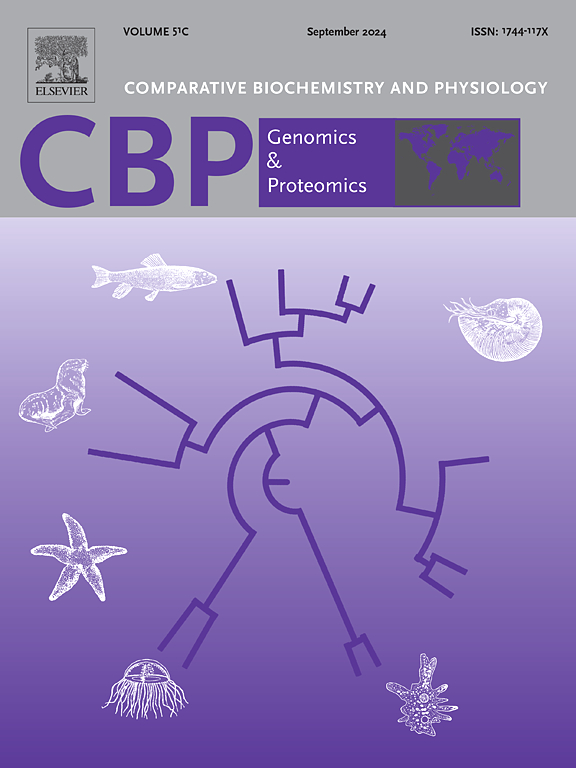Transcriptomic analysis reveals sexual dimorphism in lipid metabolism within largemouth bass (Micropterus salmoides) fed the high-fat diet
IF 2.2
2区 生物学
Q4 BIOCHEMISTRY & MOLECULAR BIOLOGY
Comparative Biochemistry and Physiology D-Genomics & Proteomics
Pub Date : 2025-05-10
DOI:10.1016/j.cbd.2025.101533
引用次数: 0
Abstract
The study presented the differential responses of male and female largemouth bass fed a high-fat diet, focusing on growth performance, hepatic transcriptomics, and lipid metabolism. The high-fat diet, 50.23 % crude protein and 19.46 % crude fat, was formulated and fed to female and male largemouth bass for 73 days separately. Growth parameters, such as final weight, weight gain (WG) and specific growth rate (SGR), demonstrated superior performance in males compared to females fed the high-fat diet. Hepatic transcriptomic analysis between the sexes under high-fat diet revealed totally 267 differentially expressed genes (DEGs), of which 132 were up-regulated and 135 down-regulated. Notably, genes implicated in lipid biosynthesis, such as elovl5, pap, aacs, hmgcra, fdft1, ebp, and dhcr24, were found to be down-regulated in males and are enriched in metabolic pathways. This suggests a sex-dependent modulation of lipid metabolism. Furthermore, the study revealed a stark contrast in hepatic mRNA expression levels of genes pivotal for lipid anabolism, with acc1, pparγ, srebf1, fasn, and scd being more highly expressed in females compared to males. Conversely, genes associated with lipid catabolism, including cpt1 and hsl, showed elevated expression in males. These findings underscore the interplay between sex, diet, and metabolic regulation in largemouth bass. The study's contributions to our understanding of physiological variances between male and female largemouth bass under high-fat diet are significant, offering valuable insights for the nutritional strategies to accommodate the metabolic needs of both sexes.

转录组学分析揭示了高脂肪饲料喂养的大口黑鲈(Micropterus salmoides)体内脂质代谢的性别二态性
本研究研究了饲喂高脂肪饲料的雄性和雌性大口黑鲈的差异反应,重点研究了生长性能、肝脏转录组学和脂质代谢。配制粗蛋白质含量为50.23%、粗脂肪含量为19.46%的高脂肪饲料,分别饲喂大口黑鲈雌、雄鱼73 d。最终体重、增重(WG)和特定生长率(SGR)等生长参数显示,雄性的表现优于饲喂高脂肪饲料的雌性。高脂饮食下的两性肝脏转录组学分析显示,共有267个差异表达基因(DEGs),其中132个表达上调,135个表达下调。值得注意的是,与脂质生物合成有关的基因,如elovl5、pap、aacs、hmgcra、fdft1、ebp和dhcr24,在雄性中被发现下调,并在代谢途径中富集。这表明脂质代谢存在性别依赖性调节。此外,该研究还揭示了脂质合成代谢关键基因的肝脏mRNA表达水平的鲜明对比,acc1、pparγ、srebf1、fasn和scd在女性中的表达水平高于男性。相反,与脂质分解代谢相关的基因,包括cpt1和hsl,在男性中表达升高。这些发现强调了大口黑鲈性别、饮食和代谢调节之间的相互作用。该研究对我们了解高脂肪饮食下雄性和雌性大口黑鲈的生理差异具有重要意义,为适应两性代谢需求的营养策略提供了有价值的见解。
本文章由计算机程序翻译,如有差异,请以英文原文为准。
求助全文
约1分钟内获得全文
求助全文
来源期刊
CiteScore
5.10
自引率
3.30%
发文量
69
审稿时长
33 days
期刊介绍:
Comparative Biochemistry & Physiology (CBP) publishes papers in comparative, environmental and evolutionary physiology.
Part D: Genomics and Proteomics (CBPD), focuses on “omics” approaches to physiology, including comparative and functional genomics, metagenomics, transcriptomics, proteomics, metabolomics, and lipidomics. Most studies employ “omics” and/or system biology to test specific hypotheses about molecular and biochemical mechanisms underlying physiological responses to the environment. We encourage papers that address fundamental questions in comparative physiology and biochemistry rather than studies with a focus that is purely technical, methodological or descriptive in nature.

 求助内容:
求助内容: 应助结果提醒方式:
应助结果提醒方式:


